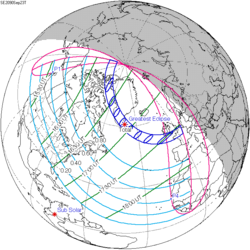| Hybrid eclipse | |
| Gamma | 0.2845 |
|---|---|
| Magnitude | 1.0011 |
| Maximum eclipse | |
| Duration | 8 s (0 min 8 s) |
| Coordinates | 6°00′S32°24′W / 6°S 32.4°W |
| Max. width of band | 4 km (2.5 mi) |
| Times (UTC) | |
| Greatest eclipse | 14:03:43 |
| References | |
| Saros | 143 (26 of 72) |
| Catalog # (SE5000) | 9659 |
A total solar eclipse will occur at the Moon's ascending node of orbit on Tuesday, December 6, 2067, [1] with a magnitude of 1.0011. It is a hybrid event, beginning and ending as an annular eclipse. A solar eclipse occurs when the Moon passes between Earth and the Sun, thereby totally or partly obscuring the image of the Sun for a viewer on Earth. A total solar eclipse occurs when the Moon's apparent diameter is larger than the Sun's, blocking all direct sunlight, turning day into darkness. Totality occurs in a narrow path across Earth's surface, with the partial solar eclipse visible over a surrounding region thousands of kilometres wide. Occurring about 3.4 days before perigee (on December 10, 2067, at 0:40 UTC), the Moon's apparent diameter will be larger. [2]
Contents
- Eclipse details
- Eclipse season
- Related eclipses
- Eclipses in 2067
- Metonic
- Tzolkinex
- Half-Saros
- Tritos
- Solar Saros 143
- Inex
- Triad
- Solar eclipses of 2065–2069
- Saros 143
- Metonic series
- Tritos series
- Inex series
- Notes
- References
The path of the eclipse will be visible as an annular eclipse from parts of southeastern Mexico, Guatemala, southern Belize, Honduras, Nicaragua, Colombia, Venezuela, Brazil, and Guyana before transitioning to a total eclipse. Totality will be visible from parts of Brazil before the eclipse transforms back to an annular eclipse, then passing over Nigeria, Cameroon, Chad, and Sudan. A partial solar eclipse will also be visible for parts of eastern North America, Central America, the Caribbean, northern and central South America, southern Europe, and Africa.







































































































